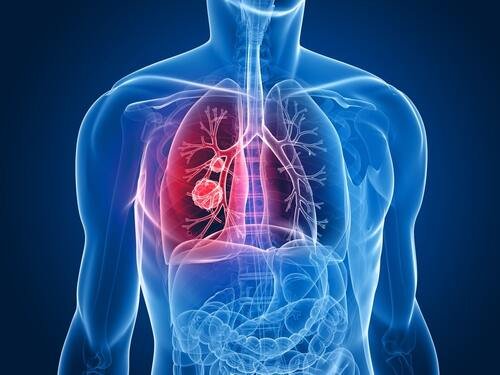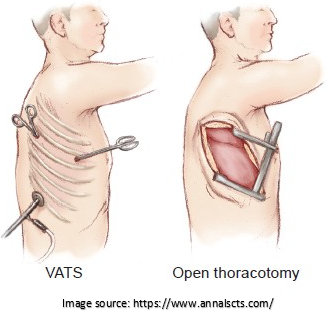Lung Cancer Treatment in Bangalore
Lung cancer is the most common cancer among Indian men. Because lung cancer has a low index of suspicion, most patients are in advanced stages when they arrive.
Lung cancer develops when abnormal cells proliferate uncontrollably in one or both lungs. The lungs are responsible for supplying oxygen to the body, and abnormal cells prevent healthy lung tissue from working properly. Cancer usually begins in the lining of the airway.
Dr. Sandeep Nayak offers comprehensive and specialized cancer treatment in Bangalore. He is one of the best oncologist in India.
Moreover, he has extensive experience detecting lung and other pulmonary anomalies early, resulting in excellent outcomes of lung cancer treatment in Bangalore.
We will discuss the symptoms, diagnosis, and Lung Cancer Treatment in Bangalore in this article.
Let’s look at the,
Signs and Symptoms of Lung Cancer
Lung cancer symptoms don’t always appear until the disease is in its advanced stage. On the other hand, some patients develop symptoms early. Here are some of the following signs and symptoms:
- Persistent cough
- Wheezing
- Blood in the sputum or phlegm
- Hoarseness
- Weakness
- Recurring or persistent infections
- Aggravating chest pain on coughing or laughing.
The following are some of the signs of advanced lung cancer:
- Breathing problems
- Severe chest pain
- Unintended weight loss
- Fatigue
These are the symptoms of cancer spreading to other parts of the body:
- Bone ache
- Headache
- Drooping eyelids
- Muscle deterioration
Let’s know the,
Different Types of Lung Cancer
The two most common types of lung cancer are small-cell and non-small-cell lung cancer. This classification is based on cancer cells’ microscopic appearance and biological behavior.
Small-cell lung carcinoma (SCLC)
The incidence of small cell lung cancer is lower than that of non-small cell lung cancer. Because of the structure of the cells, it is also known as oat cell carcinoma. It spreads quickly and has few visible symptoms at first.
Non-small-cell lung carcinoma (NSCLC)
They include cancers such as adenocarcinoma, squamous cell carcinoma, bronchioloalveolar cell carcinoma, large cell carcinoma, and others.
Lung Cancer Diagnosis
The first steps in diagnosing lung cancer are a consultation with your doctor and a physical examination. The doctor may go over your medical history and inquire about your symptoms.
To confirm the diagnosis, Dr. Sandeep Nayak, a proficient surgical oncologist in Bangalore, may suggest the following tests:
- Imaging tests: X-rays, CT scans, MRIs, and PET scans can show an abnormal mass. These scans provide more information and assist in the detection of smaller lesions.
- Sputum cytology: A microscopic examination of the sputum can reveal whether cancer cells are present if you cough up phlegm.
- Bronchoscopy: Under sedation, the doctor passes a lighted tube down the throat to your lungs, allowing a closer examination of your lung tissue.
If required, your doctor may suggest a biopsy. A biopsy involves taking a small sample of lung tissue and examining it under a microscope. A biopsy can be used to determine whether or not tumor cells are cancerous.
One of the following methods can be used to perform a biopsy:
- Mediastinoscopy: The doctor will make an incision at the base of the neck during this procedure. Then, using a lighted instrument and surgical tools under general anesthesia, collect lymph node specimens.
- Lung needle biopsy: During this procedure, the doctor inserts a needle into the suspicious lung tissue through the chest wall. A needle biopsy can also be used to examine lymph nodes.
If you have a positive biopsy, you may need additional tests, such as a bone scan, to determine whether the cancer has spread and its stage.
Staging of Lung Cancer
If lung cancer is diagnosed, several other tests are performed to determine how far cancer has spread throughout the lungs, lymph nodes, and other body parts. The type and stage of lung cancer help choose the treatment options.
Staging enables a doctor to fully comprehend the extent of a patient’s cancer to make treatment decisions and predict expected outcomes.
Cancer stages are described by using specific terminology.
The following is a simple way to describe staging:
- Localized: Only the lungs are affected in this stage.
- Regional: Cancer has spread to the chest lymph nodes (or glands) at this stage.
- Distant: Cancer has spread to other body parts.
Lung Cancer Treatment
Dr. Sandeep Nayak provides his patients with advanced and comprehensive lung cancer treatment in Bangalore. The most common lung cancer treatments are surgery, chemotherapy, and radiotherapy. Newer cancer treatments, such as targeted therapy and immunotherapy, are used occasionally, but only in the disease’s most advanced stages.
Your treatment options depend on the type of lung cancer, the disease’s stage, your lungs’ strength, and your overall health. Specific details about your health and the cancer stage at the diagnosis will determine your treatment plan.
Treatment for non-small cell lung cancer differs from patient to patient and depends on the stage:
- Stage 1 NSCLC: During surgery, a tiny portion of the lung may only need to be removed. The doctor may recommend chemotherapy, particularly if you have a high risk of relapse. Cancer is most treatable if diagnosed earlier.
- Stage 2 NSCLC: You may need surgery to remove part or all of your lungs if you have stage 2 NSCLC. Chemotherapy is usually prescribed.
- Stage 3 NSCLC: The doctor may suggest a combination of chemotherapy, surgery, and radiotherapy.
- Stage 4 NSCLC: Surgery, chemotherapy, radiotherapy, targeted therapy, and immunotherapy are all treatment options for stage 4 NSCLC.
Small-cell lung cancer (SCLC) can be treated with surgery, chemotherapy, and radiotherapy. In most cases, cancer has progressed to the point where surgery is no longer an effective option.
Surgery for Lung Cancer
Surgery is widely used to treat early-stage lung cancer. If the tumor and surrounding lung tissue are removed, patients with localized diseases have the best chance of being cured. Your surgeon will determine the resectability of a tumor. Because of their proximity to or invasion of vital structures, not all tumors are suitable for surgical resection.
Surgery may not be the best option for patients with multiple medical issues or poor lung function. When resection is required, Dr. Sandeep Nayak mostly considers minimally invasive approaches. He usually performs VATS lobectomy, video-assisted thoracic surgery (VATS), and robotic surgery for treating lung cancer.
Surgical resection of lung cancer is typically performed as follows:
- Limited resection: A wedge or segmental resection is an operation in which only a tiny portion of the lung is removed.
- Lobectomy: The surgical removal of a specific lung lobe is known as a lobectomy.
- Pneumonectomy: The surgical removal of an entire lung is known as a pneumonectomy.
Lung Cancer Surgery Recovery
The scope of the surgery, whether performed through minimally invasive options, the patient’s age, and overall health, all influence how long it takes to recover from thoracic surgery. Many patients can return home three to four days after surgery. Patients who have undergone minimally invasive surgery can usually return to work within three to four weeks.
FREQUENTLY ASKED QUESTIONS
Can smoking lead to lung cancer?
There is no one-size-fits-all answer to whether prostate cancer can be 100% cured, as the prognosis and treatment outcome for prostate cancer can vary greatly depending on a number of factors, including the stage and grade of the cancer, the patient’s age and overall health, and the type of treatment received.
What factors put you at risk of developing lung cancer?
Other risks for lung cancer, besides smoking, tobacco use, or second-hand smoke, include contact with cancer-causing agents like airborne pollutants, asbestos, arsenic, or radon, consumption of specific nutritional supplements such as beta carotene, and a personal or family history of lung cancer.
What are the side effects of treatment?
Depending on the type of treatment used, lung cancer treatment can have a variety of side effects:
- Extreme fatigue, hair loss, difficulty eating, an increased risk of infection, bowel problems, dysentery, bleeding and bruising, and a low RBC count are all side effects of chemotherapy.
- Inflammation, tenderness, and sensitive skin near the radiation treatment site are all symptoms of radiotherapy.
- Anesthesia reaction, difficulty breathing, pain, wound infection, blood clots in the lower extremities or lungs, excessive bleeding, and pneumonia are all possible complications following surgery.
At what stage is prostate cancer not curable?
Prostate cancer can sometimes be curable even when it has spread beyond the prostate gland (metastasized), but the chances of a cure decrease as the cancer progresses. The specific stage at which prostate cancer is no longer considered curable can vary, but in general, if the cancer has spread to other parts of the body and is not responding to treatment, it may be considered incurable. It is important to consult with a healthcare provider to determine the best course of action for an individual’s specific case of prostate cancer.
Is it possible to detect lung cancer by taking a blood test?
Although there are currently no blood tests to detect lung cancer, tumor sampling research is ongoing to help develop future lab tests and a deeper understanding of distinguishing between malignant and benign tumors to determine overall risk factors.


